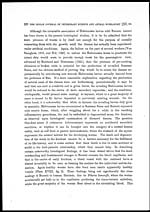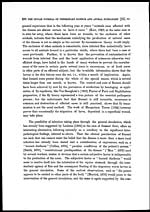Medicine - Veterinary > Veterinary colleges and laboratories > Indian journal of veterinary science and animal husbandry > Volume 3, 1933 > Original articles > Etiology of bursati
(287) Page 229
Download files
Individual page:
Thumbnail gallery: Grid view | List view

THE ETIOLOGY OF BURSATI 229
analogy should be kept in mind, since certain well-known but hitherto unaccount-
able clinical facts of Bursati can now be explained on this view.
In the light of the present histological findings, Bursati, at any rate as it
occurs in India, appears to be a single disease entity, the presence of moulds in
open sores having no significance ; for, it has been shown above that the diagnos-
tic lesions of Bursati are represented by the kunkurs and that they are, histologi-
cally speaking, typical helminthic nodules, the same nematode larvae of Habro-
nema spp. having been demonstrated consistently as forming the inciting nucleus
for the production of the nodular lesions. There need now be no doubt, therefore,
regarding the helminthic as also the habronemic origin of Bursati.
With regard to the mode of infection, the position is more unsatisfactory. A
perusal of the Bursati literature shows that the fly transmission theory has been
held by the natives of India from as early a date as 1820, and that among the other
old theories, it was believed to be a blood disease [Ubique, 1877 and Ferris, 1881].
In the case of cutaneous habronemiasis, as known in different parts of the world,
the hypothesis current at present is that these helminthic granulomata are caused
by the deposition of the habronema larvae in wounds by flies. Although the
current view is undoubtedly an improvement on the old Indian belief, it will be
seen from what is stated below that it is still unacceptable, since it fails to provide
a satisfactory explanation for the known facts regarding Bursati. Contrarily,
however, it will be realised that from a consideration of certain clinical peculiari-
ties of the disease, which have been emphasised by most observers, one cannot
resist the belief that the disease is more than a mere local infection, although
there are little or no constitutional symptoms. Notable among the protagonists of
what may, for brevity, be called the fly theory, are Railliet and Henry [1915], who
suggested that habronema larvae penetrate the skin in the same manner as the
larvae of ankylostomes, but from the experimental work of several other workers,
it appears that these larvae are not able to penetrate the equine skin even when
the epidermis alone is damaged. Margarinos Torres [1924], however, claims to
have proved that the larvae of Habronema muscae, if deposited in wounds of a
guinea-pig. are able to reach the lungs, it being an organ for which they appear to
have a marked preference. The failure on the part of the present writer [1931] to
transmit the disease through the agency of flies receives support from Holmes
[1914], who states " I am unaware of recorded cases of transmission of the sore
from horse to horse by means of outside agencies ", and also in the statement of
Spooner Hart [1873]: '' Practice and time have afforded ample proof of the non-
contagiousness of Bursati, for my bursatied subjects stand among other animals
and I have never seen any ill effects ensue ". The statements quoted here and the
Set display mode to: Large image | Zoom image | Transcription
Images and transcriptions on this page, including medium image downloads, may be used under the Creative Commons Attribution 4.0 International Licence unless otherwise stated. ![]()
| Permanent URL | https://digital.nls.uk/75230335 |
|---|
| Description | Covers articles from 1933. |
|---|




